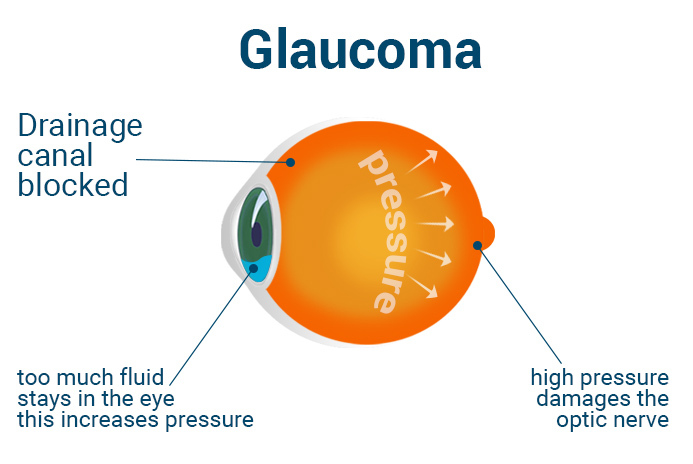Glaucoma: causes, symptoms and treatments

You're probably familiar with cataracts, a well-known eye disease. But do you know what glaucoma is or are you possibly affected by it yourself? We asked the ophthalmologist Dr Maya Mineva to explain the phenomenon of glaucoma to us in more detail and show us the treatment options. Read more about it here.
What is glaucoma and what causes it?
Glaucoma is a disease of the eye. It can have different causes, but it is often triggered by high pressure in the eye or a disturbed blood supply to the eye. Over the course of the disease, damage to the optic nerve can occur that is irreversible and can lead to blindness if left untreated. Glaucoma is one of the most widespread eye diseases in the UK.
As stated above, the causes of glaucoma vary, but the disease is most often caused by high intraocular pressure.
Intraocular pressure occurs in the chambers of the eye which are filled with aqueous humour. The aqueous humour, which flows between the lens and the cornea, is produced in the ciliary body of the eye. From there it flows from the posterior chamber of the eye into the anterior chamber and then leaves the chambers of the eye through the so-called Schlemm's canal.
It is a continuous process that supplies the lens and cornea with important nutrients. In a healthy eye, this circulation ensures a constant pressure with normal values between 10 and 21 mmHg. However, if the circulation is disturbed or the aqueous humour can't fully drain, this leads to increased intraocular pressure with values from 24 mmHg.

Increased intraocular pressure can cause damage to the nerve fibres of the optic nerve. The more resistant your optic nerve is, the smaller the damage.
The blood supply to the optic nerve is one of the factors that determine whether your eye is susceptible to glaucoma or not. If the blood supply is good, high intraocular pressure can be tolerated. Glaucoma can, however, also occur with normal eye pressure as a result of poor blood circulation. If it is insufficient the nerve cells are not supplied with sufficient nutrients and oxygen.
There are other causes of glaucoma, such as secondary damage from inflammation or injury. In a few cases, glaucoma can also be congenital or present from birth. In this case, it is called secondary glaucoma if it is caused by an existing condition.
Can you wear contact lenses if you have glaucoma?
Yes, people with glaucoma can wear contact lenses provided their doctor allows it. For example, there are certain types of eye drops designed to reduce eye pressure that must not be used in combination with contact lenses. These types of eye drops require a prescription, so you should discuss this treatment with your doctor.
If you don't experience any problems regularly wearing contact lenses despite having glaucoma, you should be able to wear them.
What are the most common types of glaucoma?
- In normal tension glaucoma, your optic nerve suffers damage not from increased intraocular pressure but from disturbed blood flow.
- With closed-angle glaucoma (also called angle-closure glaucoma), the drainage of aqueous humour is blocked, resulting in an immediate increase in intraocular pressure. Angle-closure glaucoma comes on suddenly and can have painful symptoms. This condition is also known as a glaucoma attack.
- Open-angle glaucoma is the most common type and often goes unnoticed by the patient. Due to a blocked outflow of the aqueous humour, the intraocular pressure increases and leads to chronic high pressure in the eye which slowly damages the optic nerve.
What are congenital and childhood glaucoma?
Glaucoma in children is rare but has long-lasting negative consequences, if not diagnosed in time. Due to abnormal development, anomalies in the eyeball and its fine structures it may even develop during pregnancy.
Primary glaucoma in children can develop immediately after birth, up to the age of 3, and in this case, it is referred to as congenital glaucoma. If it develops between the age of 3 and 10, then it is called childish glaucoma.
Congenital glaucoma presents a unique clinical picture that sets it apart from other types of glaucoma – the baby is restless, avoids light (photophobia), prefers to keep his or her eyes closed, rubs them, has abundant tears, and the cornea gradually loses transparency. The eyeball is abnormally enlarged and children with congenital glaucoma have impressively large eyes.
The diagnosis is made by examination of the anterior ocular segment and the optic nerve, measurements of the cornea and mesh size. Given the age of the patients, these tests are often performed under general anaesthesia.
How does glaucoma affect everyday life?

As long as you're not suffering from severe symptoms, you will still be able to manage everyday life. As damage to the optic nerve becomes more pronounced, vision can be impacted as seen in the images above. Image A represents normal vision whilst image B depicts what one might see with glaucoma.
Risks associated with glaucoma increase as vision gets worse. For example, stumbling whilst walking may start to occur and the ability to continue driving will be limited or impossible. In severe instances, patients may be dependent on additional assistance. Unfortunately, the fear of total loss of vision can be distressing as well.
What are the symptoms of glaucoma?
Symptoms vary depending on the type of glaucoma. Individuals often don't notice any symptoms for a long period of time. Glaucoma may be noticed years down the line only after the onset of vision problems such as black spots or a dark veil at the edge of the field of vision. The more severe the glaucoma, the smaller your field of vision becomes. Untreated glaucoma can lead to complete blindness. After that, it is no longer possible to restore vision.
Angle-closure glaucoma can cause a glaucoma attack. This is often associated with an acute visual disturbance, severe headaches, nausea or reddened eyes. A glaucoma attack is an emergency and should be treated immediately by an ophthalmologist. In order to limit the course of the visual field loss, regular visits to the ophthalmologist are necessary. They will introduce you to the different treatments.
How can you diagnose glaucoma?
There are different ways to identify glaucoma. Among the factors listed, the family history is very important – this is essential information that you must share with your eye doctor.
Then comes the monitoring of various parameters through specialised studies – intraocular pressure control, corneal thickness measurement and a peripheral vision examination. The condition of the optic nerve is paramount and should be examined using the most appropriate methods.
The most popular choice is the Goldman's method, which provides greater precision. It requires a special prism mounted on the biomicroscope, a dye substance and a local anaesthetic.
Furthermore, genetic studies allow us to identify patients who carry the genetic factors responsible for the development of glaucoma, so that they can be closely monitored and start treatment at an early stage, to preserve vision.
What are the treatment options?
Unfortunately, there is no cure for damage caused by glaucoma, but timely treatment can limit the damage and slow the progression of the disease. Therefore, it's advisable to have your eyes examined regularly by an expert.
Even before you experience symptoms, your doctor can detect glaucoma and start treatment immediately. At each routine exam, your visual acuity and intraocular pressure will be measured and your visual field will be checked. If glaucoma is suspected, your optic nerve will also be examined. Using state-of-the-art equipment such as a slit lamp, your eye doctor can take a closer look at your optic nerve. They will be able to tell how far your glaucoma has progressed after the examination.
If the intraocular pressure is elevated, the chamber angle is also checked. If the outflow of the aqueous humour is disturbed, eye drops are often used. If medication and eye drops do not produce a sufficient effect, surgical procedures can normalise the outflow of the aqueous humour again. Laser treatment or surgery creates an additional outflow channel for the aqueous humour or enlarges the existing channel. Normalising the pressure relieves the optic nerve, thus delaying or stopping the gradual loss of vision.
What are the risk factors for glaucoma?
Anyone can be affected by glaucoma. However, there are several factors that contribute to an increased risk:
- Severely elevated intraocular pressure
- Advanced age
- Family history
- Nearsightedness
- Diabetes
- Circulatory diseases
Want to learn more about diseases like glaucoma? Read the Lentiamo guide on eye diseases.
Read more
Want to know more? Read the eye diseases guide to learn about topics such as eye stroke or cataract surgery.
Sources
1. Woche des Sehens, Augenkrankheiten – Zahlen für Deutschland
2. National Library of Medicine, What Do Patients With Glaucoma See? Visual Symptoms Reported by Patients With Glaucoma







Comments